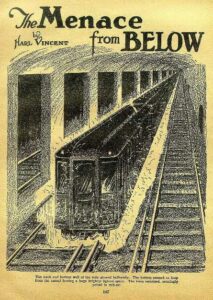Dive into Harl Vincent’s 1929 pulp sci-fi tale The Menace From Below—vanishing trains, underground horrors & retro-futurism in this vintage thriller!
Harl Vincent’s “The Menace From Below,” published in the July 1929 issue of Science Wonder Stories, stands as a strong example of early pulp science fiction. This brisk adventure mixes scientific intrigue, underground danger, and tight mystery. At its centre is a vengeful mad scientist who builds an army from kidnapped New Yorkers in his hidden subterranean base. As a result, the tale blends detective-style adventure with speculative science in a way that suits Science Wonder Stories’ editorial direction. Vincent writes in a classic pulp mode—energetic, descriptive, and full of exclamatory dialogue and cliffhanger moments. The characters follow familiar archetypes: the capable engineer-hero, the loyal partner, and the gifted inventor.
Plot Summary of The Menace From Below
The plot opens with a dramatic and unsettling event: a train carrying 500 passengers vanishes inside an East River tunnel. Engineer Ward Platt and his colleague Charlie Frazee join inventor Tony Russell to investigate the disappearance. As the trio dig deeper into the mystery, they encounter a series of bizarre scientific threats. These dangers steadily push the narrative from puzzle-solving to full-tilt action, eventually leading them face to face with the underground menace responsible for the kidnappings.
Themes and the Underground Menace Motif
“The Menace From Below” explores themes typical of early science fiction. Foremost is the idea of unrestrained scientific progress stripped of moral responsibility. The antagonist reflects a common pulp figure: the brilliant but bitter scientist turned destructive.
Vincent often returned to underground threats in his work. Here, the mad scientist aims to create a superhuman army by grafting parts of human brains into ape-like subterranean creatures. This underground setting carries symbolic impact. Subterranean worlds had long appeared in speculative fiction, from Jules Verne’s Journey to the Centre of the Earth to Edgar Rice Burroughs’ Pellucidar tales. Vincent treats the underground as a space where society’s rules vanish and dangerous experimentation flourishes unchecked.
It’s also worth noting that subways and tunnels were still relatively new in 1929. They represented both urban progress and hidden risk. Vincent uses these anxieties effectively, playing on fears about what might lurk beneath modern cities.
Scientific Speculation and Prophetic Elements
The story touches on scientific concepts that later proved surprisingly forward-looking. References to atomic energy and television communication—both emerging technologies in 1929—show how pulp fiction allowed writers to explore imagined futures. Although the explanations here aren’t rigorous, they mirror genuine scientific debates of the time.
The brain-transfer idea, though implausible, reflects contemporary fascination with neurology and the physical nature of consciousness. The 1920s brought major breakthroughs in brain science, prompting speculative writers to ask whether consciousness could be moved, copied, or artificially altered.
Atomic energy mentions are especially striking, given that practical atomic power was still decades away. Science fiction frequently imagined atomic energy as a near-limitless resource long before it became associated with weapons development.
“The Menace From Below” holds an important place in early science fiction—not because it revolutionised the genre, but because it shows how pulp conventions formed and how professional writers like Vincent supported the magazines that allowed science fiction to grow. Published in only the second issue of Science Wonder Stories, it helped define Hugo Gernsback’s vision of science fiction as both thrilling and educational.
Author: Harl Vincent
Harl Vincent was the pen name of Harold Vincent Schoepflin (1893–1968), an American mechanical engineer turned science fiction author. His career began after discovering Hugo Gernsback’s Amazing Stories. His first published tale, “The Golden Girl of Munan,” appeared in June 1928. Although not as well-known as E.E. “Doc” Smith, Vincent exemplified the reliable pulp professional who supplied energetic, idea-driven fiction month after month.
My Thoughts
Vincent’s prose in “The Menace From Below” is pulp fiction at its most typical. The writing favours clarity and momentum over stylistic subtlety. Sentences stay direct, descriptions remain lean, and dialogue drives the action forward. The goal is simple: sketch vivid scenes quickly and keep readers turning pages.
Characters often speak in heightened bursts when danger looms: “Good God, what’s that?” or “We’ve got to stop him before it’s too late!” While such expressions might feel melodramatic today, they once signalled urgency and helped maintain the story’s pace.
Vincent builds the narrative through steady escalation. It begins with mystery, moves through investigation, rises to a direct clash with the underground threat, and concludes with the defeat of the mad scientist. This rising three-act structure became a standard template for pulp adventures, giving readers a satisfying arc within tight magazine limits.
Wrapping Up
“The Menace From Below” captures science fiction at a formative stage. Published in 1929, it arrived when the genre was barely three years old as a marketed category and was still finding its voice. The story also appeared just before the Great Depression reshaped both American society and the pulp-publishing world.
It delivers exactly what early pulp SF promised: brisk action, imaginative speculation, and adventurous tension framed by scientific curiosity and danger. Vincent’s subterranean realm, his mad scientist, and the threatened city embody many early science-fiction essentials.
For modern readers interested in the roots of the genre, “The Menace From Below” offers genuine insight. It shows how science fiction established itself in the pulp marketplace, what captivated readers in the late 1920s, and how commercially driven writers built the foundations for the science fiction that followed.
If you’re keen to explore more classic stories or related analyses, feel free to browse the other posts listed below.
Other stories from Science Wonder Stories, Vol. 1, No. 2
The Alien Intelligence
More of Subterranean Horror-Adventure
Another vintage pulp magazine:
Science Wonder Stories, Vol. 1, No. 2
Original Science Wonder Stories issues at the Internet Archive.
Disclaimer: The story featured on this page is in the public domain. However, the original authorship, magazine credits, and any associated illustrations remain the property of their respective creators, illustrators and publishers. This material is provided for informational and educational purposes only and may not be used for commercial sale.

